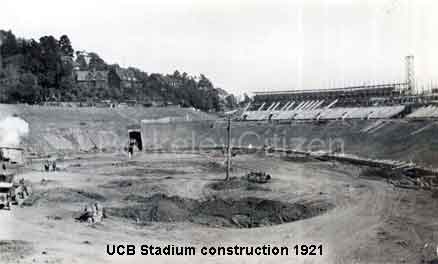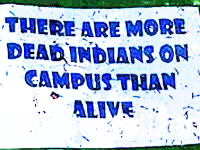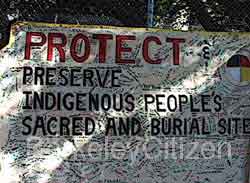Stadium Excavation Reveals Relics of Human Bones and Ancient Coin
Daily Californian, February 23, 1923 Page 1.
An old coin and fragments of human bones were unearthed a few days ago by workmen excavating for the Stadium. These relics were discovered about 35 feet north of the site where the remains of the Indian skeleton were discovered six weeks ago. The letters “N-O-R-A” and indistinct vestiges of two other letters can be made out on the face of the coin.
Although the nature of the piece of money has not yet been clearly identified. Prof A. T. Kroeber of the anthropology department believes that the coin is probably Mexican and from the state of Sonora.
Believes Coin Came From Sonora
In the second quarter of the nineteenth century, Sonora was an independent state and had a separate system of coinage. At the time California was taken possession by the Mexicans the Sonora coinage was probably circulated as far north as Berkeley.
 The connection of the coin to the bones is not clear since the latter appeared to be much older. Only two or three ribs and other small particles of a skeleton remain distinguishable in the recent excavation. The bones found a few weeks ago were little disintegrated and were judged to be comparatively recent.
The connection of the coin to the bones is not clear since the latter appeared to be much older. Only two or three ribs and other small particles of a skeleton remain distinguishable in the recent excavation. The bones found a few weeks ago were little disintegrated and were judged to be comparatively recent.
Cannot Estimate Age of Bones
Dr. Kroeber states, however that the soil conditions affect the rate of bone decay so greatly that age of the bones cannot be accurately estimated. The coin may have been buried with the body of the Indian or may have been lost and covered up gradually. It is not likely that any large Indian burying ground will be discovered in Strawberry Canyon during the excavations as Professor Kroeber says that most of the Indians in this part of the country were taken to missions at San Francisco or San Jose for burial.
•••••••••••••••
Tree-sitters say site might be burial ground
Human skeleton was found on site in 1923, but origin unknown
Carolyn Jones, SF Chronicle, February 21, 2007
The tree-sitters hoping to stop an athletic training center next to Memorial Stadium in Berkeley say the site may deserve protection as home to a American Indian burial ground.
 The protesters, who have been roosting in the oak grove since Dec. 2, pointed Tuesday to a UC archaeological survey from 1925 stating that human remains were removed from the area when the stadium was constructed.
The protesters, who have been roosting in the oak grove since Dec. 2, pointed Tuesday to a UC archaeological survey from 1925 stating that human remains were removed from the area when the stadium was constructed.
"I think this is a significant find and the area should be protected," said Stephan Volker, attorney for the California Oak Foundation, one of four groups suing UC over the proposed renovation of Memorial Stadium and construction of the $125 million sports training center. The center would uproot oak trees that the protesters want saved.
Volker said his group's lawsuit will be amended to reflect the presence of the remains.
The university's environmental impact report did not specifically address the archaeological significance of the site, Volker said. American Indian remains are protected by federal law, which doesn't preclude development but says that descendants and the local Native American Heritage Commission must oversee any remains removal.
Campus spokeswoman Marie Felde said the report does address the possibility of American Indian remains in the area.
The report says "there's a high likelihood of archaeological sites within the site boundaries," said Felde. "We're aware of this and we will deal with it when it comes up."
The director of the university's Phoebe A. Hearst Museum of Anthropology, Kent Lightfoot, said a partial skeleton was unearthed and removed during stadium construction in 1923 but that existing records do not point to a burial ground or settlement. Nor does the record indicate the ethnicity of the remains.
 "There's no indication that this isolated skeleton is part of a larger archaeological site," said Lightfoot, also a professor of anthropology and the museum's curator of North American archaeology. "It probably is an isolated find."
"There's no indication that this isolated skeleton is part of a larger archaeological site," said Lightfoot, also a professor of anthropology and the museum's curator of North American archaeology. "It probably is an isolated find."
He said the only known artifact associated with the skeleton was a Mexican coin, which was listed in a hand-written note added to the typed site-survey record as dating from the "second quarter of 19th century."
Before any development occurs, he said, the campus would conduct a thorough archaeological survey of the site in conformance with applicable state and federal requirements.
Some confusion surrounded the site survey record on Tuesday because two sites are alluded to -- the stadium and the Faculty Glade near the center of campus.
According to Volker, the 1925 survey was done by Leslie Spier, an assistant professor of anthropology at University of Washington, who allegedly found that the remains belonged to a tribe separate from the Ohlone.
The tree-sitters learned of the remains when an anonymous sympathizer provided a copy of a 1925 site-survey record about the stadium site and a 1925 clipping from the San Francisco Examiner, which said three skeletons had been found at the Faculty Glade site as part of what Spier believed was a American Indian burial site. The newspaper also said "several more" skeletons were found during the building of the stadium but did not indicate whether they were believed to be American Indian.
A small number of tree supporters held a news conference and a prayer ceremony at the oak grove Tuesday.
As he burned sage, Wounded Knee Deocampo from the Vallejo Intertribal Council, prayed, "I ask you grandfathers and grandmothers and the creator to protect the tree people and protect this site from being desecrated and destroyed by man." He also said, "It is time to put a halt to digging up sacred sites. We would never dig up your cemeteries. These are sacred places as much as the pyramids of Egypt."
Corrina Gould, an Ohlone Indian from Berkeley, said, "These are sacred sites for the Ohlone. We are still living. We are not in the past."
The oak grove has not been excavated, but it's likely that an Ohlone village was in the general area, said Malcolm Margolin, author of "The Ohlone Way" and publisher of Heyday Books in Berkeley.
"That would have been a prime spot for a settlement. It was above the marshes, there was firewood from the oak groves, a creek ran nearby," he said. "It's a very, very desirable location. It's why UC was founded there."
http://sfgate.com/cgi-bin/article.cgi?f
